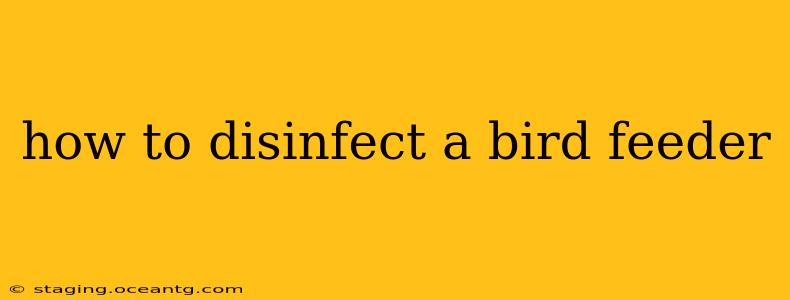Bird feeders are a wonderful way to enjoy the beauty of nature up close, but they can also become breeding grounds for bacteria and parasites if not properly cleaned and disinfected. Failing to do so can lead to the spread of diseases among your feathered visitors, potentially causing illness or even death. This comprehensive guide will walk you through the best practices for disinfecting your bird feeder, ensuring your avian friends stay happy and healthy.
Why Disinfect Your Bird Feeder?
Regular cleaning and disinfecting of your bird feeder is crucial for several reasons:
- Disease Prevention: Bird feeders can harbor harmful bacteria, fungi, and parasites like Eimeria and Salmonella, which can easily spread among birds, causing illness and even death. Regular cleaning minimizes this risk significantly.
- Mold Prevention: Spilled seeds and damp conditions can lead to mold growth, which is toxic to birds. Disinfection eliminates mold spores and prevents future growth.
- Attracting Healthy Birds: A clean feeder ensures you attract healthy birds, providing a better viewing experience for you and a safer environment for them.
How Often Should You Clean Your Bird Feeder?
The frequency of cleaning depends on the weather and the type of feeder:
- Weekly: During warm, humid weather, especially during and after periods of rain, weekly cleaning is recommended to prevent mold and bacterial growth.
- Every Two Weeks: In cooler, drier climates, cleaning every two weeks is often sufficient.
- As Needed: If you notice any mold, mildew, or significant seed build-up, clean your feeder immediately.
What You'll Need to Disinfect Your Bird Feeder:
- Mild Dish Soap: Avoid harsh chemicals.
- Hot Water: Use the hottest water you can comfortably handle.
- Stiff Brush: A bottle brush is ideal for cleaning hard-to-reach areas.
- Disinfectant Solution: A 10% bleach solution (1 part bleach to 9 parts water) or a commercially available bird feeder disinfectant is effective. Always rinse thoroughly after using any disinfectant.
- Gloves: Protect your hands while cleaning.
- Towels: For drying.
Step-by-Step Guide to Disinfecting Your Bird Feeder:
-
Empty the Feeder: Remove all remaining seeds and debris from the feeder. Dispose of old seeds properly to prevent attracting unwanted pests.
-
Pre-Clean the Feeder: Wash the feeder thoroughly with hot, soapy water and the stiff brush. Pay close attention to crevices and areas where seeds tend to accumulate.
-
Rinse Thoroughly: Rinse the feeder completely to remove all soap residue. Soap residue can be harmful to birds.
-
Disinfect the Feeder: Prepare your disinfectant solution (bleach or commercial disinfectant) according to the instructions. Submerge the feeder in the solution, ensuring all surfaces are coated. Allow it to soak for at least 10 minutes. For particularly stubborn dirt or mold, you may need to let it soak for longer.
-
Rinse Again: Thoroughly rinse the feeder with clean, hot water to remove all traces of the disinfectant. Residual disinfectant can be harmful to birds.
-
Dry Completely: Allow the feeder to air dry completely before refilling. This helps prevent mold growth.
What are the best ways to prevent bird feeder diseases?
Offering a variety of high-quality seeds and regularly replenishing the supply will reduce the likelihood of contamination and disease spread. Consider providing multiple feeders to avoid overcrowding and competition, lessening the chance of birds spreading germs through direct contact.
How do I clean a metal bird feeder?
Cleaning a metal bird feeder follows the same steps as cleaning other types of feeders. However, be extra cautious when using bleach solutions on certain metals as it can cause corrosion. Consider using a specialized bird feeder disinfectant instead.
How do I clean a wooden bird feeder?
Wooden feeders require extra care. Avoid soaking them for extended periods, as this can damage the wood. Clean gently with a brush and soapy water and use a diluted bleach solution sparingly. Let it air dry completely in a well-ventilated area to prevent mold.
What should I do if I see sick birds at my feeder?
If you notice sick or dead birds at your feeder, immediately clean and disinfect the feeder thoroughly. Contact your local wildlife rehabilitation center or animal control for guidance on how to proceed.
By following these simple steps, you can significantly reduce the risk of disease transmission among birds visiting your feeder, ensuring their health and providing a safe and enjoyable feeding experience for both you and your feathered friends. Remember, a clean feeder is a happy feeder!
